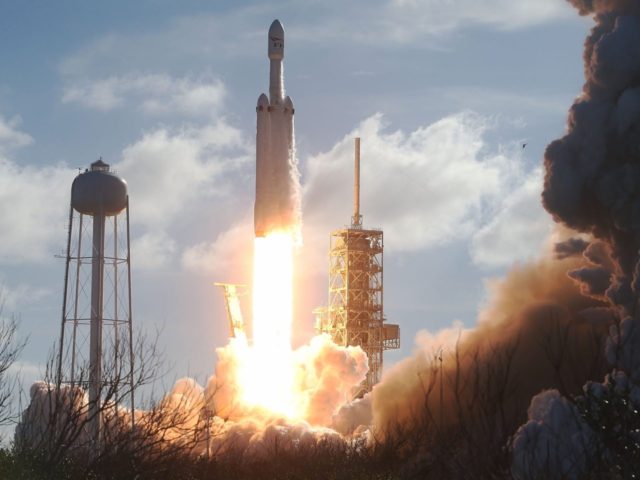SpaceX’s mammoth 27-engine Falcon Heavy rocket flawlessly lifted off from the Kennedy Space Center at Cape Canaveral, Florida, on Tuesday and launched a small craft to Mars as a symbolic effort at interplanetary travel.
After upper atmosphere winds subsided, with just 15 minutes left before the mission would have had to be scrubbed for the day, all three booster engines sets produced 5-mllion pounds of thrust to power the 230-foot-high Falcon Heavy into space.
SpaceX Chairman Elon Musk refers to Falcon Heavy as the “Big F***ing Rocket,” or “BFD,” because it has the capability of lifting 140,700 pounds of payload into space. That gives Falcon Heavy twice the capability of the current big satellite lift leader, United Launch Alliance’s Delta IV Heavy Booster.
About eight minutes after blast-off, both side-mounted boosters on Falcon Heavy made picture perfect side-by-side upright intact landings at Kennedy Air Force Station LZ-1 and LZ-2, seven miles south of the launch site.
The main core booster rocketapproached its recovery platform perfectly in the mid-Atlantic. But after the rocket flipped correctly, its recovery engine failed to ignite, and the rocket hit the ocean at 300 miles-per-hour and sank near its recovery platform.
Prior to lift-off, Musk was sheepishly claiming that there was only a 50-50 chance for a successful Falcon Heavy first-time launch. His humility regarding the technical challenges of the mission was probably related to SpaceX president Gwynne Shotwell telling reporters last May that the company had a success rate of 94 percent. SpaceX subsequently suffered a couple wildly expensive satellite-launch failures.
SpaceX plans to charge only $90 million per launch for its Falcon Heavy’s private sector booster, representing a death knell for NASA’s $35 billion Space Launch System. Passed by the Obama administration at the height of its Democrat-majority control of Congress in 2010, the federal government-owned-and-operated “SLS” had planned to charge $1 billion per launch.
Musk loaded a Tesla midnight-cherry-red Roadster convertible in the rocket’s nose cone. After reaching space, the nose cone’s protective fairings separated to reveal a “Starman” dummy in the driver’s seat, and the Roadster’s radio playing a continuous loop of David Bowie’s “Life on Mars” song. Musk indicated that he expects Starman will continue to broadcast from his Tesla Roadster as he orbits around the “Red Planet.”

COMMENTS
Please let us know if you're having issues with commenting.